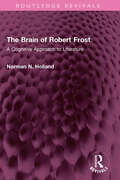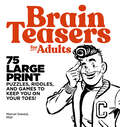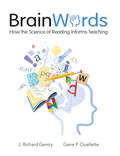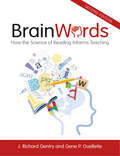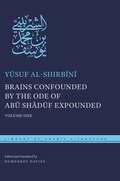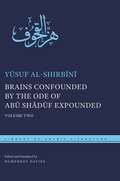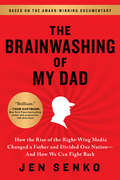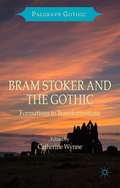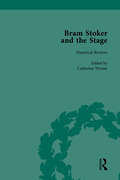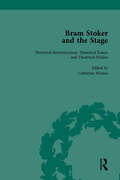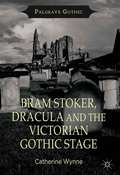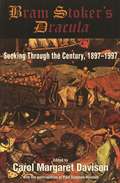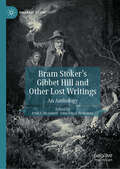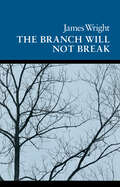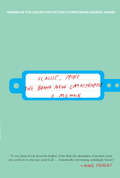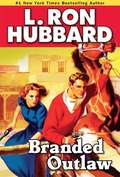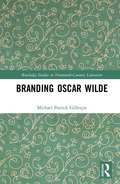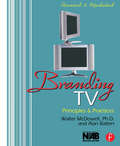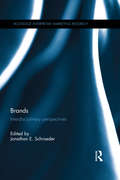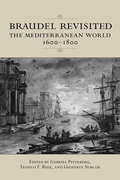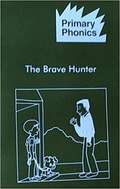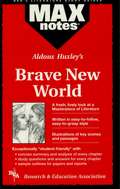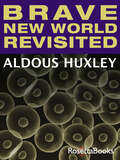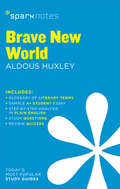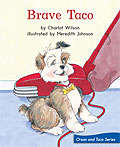- Table View
- List View
The Brain of Robert Frost: A Cognitive Approach to Literature (Routledge Revivals)
by Norman N. HollandOriginally published in 1988, this book brings brain science to literary criticism. The Brain of Robert Frost combines psychoanalysis with the findings of brain research and cognitive psychology to model the way we create and respond to literature. Norman Holland draws three central ideas from ‘the mind’s new science’: the critical ‘supercharged’ period in infancy when individuality is formed; the binding of emotion to intellect deep in the old brain; the top-down, inside-out, feedback processing of language in the new. Then, using Robert Frost as an example both of a writer and a reader, and comparing Frost’s reading of a poem to readings by six professors of literature, Holland builds a new, powerful way of thinking about literary criticism and teaching. A book about literary cognition, The Brain of Robert Frost furthers our understanding of the reading process, of poet’s brains, and of our own.
Brain Teasers for Adults: 75 Large Print Puzzles, Riddles, and Games to Keep You on Your Toes
by Marcel DanesiGive your brain a test. Give your eyes a rest. Looking for a way to keep your brain on its toes? Well, there is nothing more mentally stimulating or fun than good old-fashioned brain teasers. And since everyday life doesn't throw perplexing riddles at us very often, Brain Teasers for Adults offers a variety of tricky, yet "doable" puzzles to help build your logic, math, and wordplay. The unique skills derived from solving brain teasers helps put you in a better position to resolve important problems from work to daily life. Go in order of difficulty or skip around—the decision is yours! Solve all 75 brain teasers and stand tall, knowing you have outsmarted the puzzle-maker himself. Inside Brain Teasers for Adults, you'll find: Choose your difficulty—Moving from simple Duck Soup Puzzles to Head Scratchers, engage your brain on different levels, with each riddle labeled by difficulty. 5 Categories—Filled with brain teasers categories such as Wordplay, Logic, Card puzzles, and more are meant to stimulate your thoughts in different ways. Clues to use—An optional clues section has been provided for each question in case a little extra help is needed! Time to discover how fun and rewarding puzzle-solving can be with Brain Teasers for Adults!
Brain Words: How the Science of Reading Informs Teaching
by J. Richard Gentry Gene OuelletteThe past two decades have brought giant leaps in our understanding of how the brain works. But these discoveries-;and all their exciting implications-;have yet to make their way into most classrooms.In Brain Words: How the Science of Reading Informs Teaching , authors J. Richard Gentry and Gene Ouellette, bring their original, research-based framework of brain words dictionaries in the brain where students store and automatically access sounds, spellings, and meaning. This book aims to fill the gap between the science of reading and classroom instruction by providing up-to-date knowledge about reading and neurological circuitry, including evidence that spelling is at the core of the reading brain.Brain Words will show how children's brains develop as they become readers and discover ways you can take concrete steps to promote this critical developmental passage, including: Incorporating tools to recognize what works, what doesn't, and whyPractical classroom activities for daily teaching and student assessmentInsights about what brain research tells us about whole language and phonics-first movementsDeepened understanding of dyslexia through the enhanced lens of brain scienceWith the insights and strategies of Brain Words , you can meet your students where they are and ensure they gain confidence as readers, spellers, and writers.
Brain Words: How the Science of Reading Informs Teaching
by J. Richard Gentry Gene P. Ouellette"Gentry and Ouellette are cannonballing into the reading research pool, they're making waves, and these waves are moving the field of reading forward."—From the foreword by Mark Weakland, Super Spellers"In this second edition, the authors have written a practical and fascinating resource that helps connect the theory and research of the neurological reading circuitry to classroom practice."—Molly Ness, teacher educator, author, consultantA lot has changed since the original publication of Brain Words. The first edition was very much a call for change, and change has indeed happened! While the science of reading has made real and substantive change within education, there unfortunately remain too many misunderstandings and misinterpretations of what the science of reading is, and stubborn resistance to all it has to offer. Now more than ever it is vital that we work towards an understanding of the science of reading and what it has to say about teaching our students how to read.Written for beginning or seasoned teachers, homeschoolers, teacher educators, as well as parents who want to fully engage in their child’s literacy development, this updated and highly readable new edition presents brain science, reading research, and theory in ways that can be understood and directly applied in teaching, ultimately leading to efficacious science of reading based literacy instruction.Gentry and Ouellette show how an understanding of the science of reading can shape teaching to help make all students literate. Building on their science of reading based framework of “brain words”—dictionaries in the brain where students store and access word spelling, pronunciation, and meaning—the authors offer a wealth of information to transform your thinking and practice. They offer: an updated review of models of reading, developmental theory, and brain research that help explain the reading brain a new exploration of how oral language provides the foundation for learning to read and write, and how elements of oral language directly contribute to literacy learning throughout the school years an evolving critique of classroom practices that aren't as effective as once believed explicit guidance on how spelling can be used to teach the critical skill of word reading a deepened understanding of dyslexia through the lens of the science of reading With the insights and strategies in Brain Words, you can meet your students where they are and ensure that more of them read well, think well, and write well.
Brains Confounded by the Ode of Abū Shādūf Expounded: Volume One (Library of Arabic Literature #Volume One)
by Yūsuf al-ShirbīnīUnique in pre-twentieth-century Arabic literature for taking the countryside as its central theme, Yūsuf al-Shirbīnī’s Brains Confounded combines a mordant satire on seventeenth-century Egyptian rural society with a hilarious parody of the verse-and-commentary genre so beloved by scholars of his day.In Volume One, al-Shirbīnī describes the three rural “types”—peasant cultivator, village man-of-religion and rural dervish—offering numerous anecdotes testifying to the ignorance, dirtiness, illiteracy, lack of proper religious understanding, and criminality of each. He follows it in Volume Two with a 47-line poem supposedly written by a peasant named Abū Shādūf, who charts the rise and fall of his fortunes and bewails, above all, the lack of access to delicious foods to which his poverty has condemned him. Wielding the scholarly tools of elite literature, al-Shirbīnī responds to the poem with derision and ridicule, dotting his satire of the ignorant rustic with numerous digressions into love, food, and flatulence.Witty, bawdy, and vicious, Brains Confounded belongs to an unrecognized genre from an understudied period in Egypt’s Ottoman history, and is a work of outstanding importance for the study of pre-modern colloquial Egyptian Arabic, pitting the “coarse” rural masses against the “refined” and urbane in a contest for cultural and religious primacy, with a heavy emphasis on the writing of verse as a yardstick of social acceptability. A bilingual Arabic-English edition.
Brains Confounded by the Ode of Abū Shādūf Expounded: Volume Two (Library of Arabic Literature #Volume Two)
by Yūsuf al-ShirbīnīUnique in pre-twentieth-century Arabic literature for taking the countryside as its central theme, Yūsuf al-Shirbīnī’s Brains Confounded combines a mordant satire on seventeenth-century Egyptian rural society with a hilarious parody of the verse-and-commentary genre so beloved by scholars of his day.In Volume One, al-Shirbīnī describes the three rural “types”—peasant cultivator, village man-of-religion and rural dervish—offering numerous anecdotes testifying to the ignorance, dirtiness, illiteracy, lack of proper religious understanding, and criminality of each. He follows it in Volume Two with a 47-line poem supposedly written by a peasant named Abū Shādūf, who charts the rise and fall of his fortunes and bewails, above all, the lack of access to delicious foods to which his poverty has condemned him. Wielding the scholarly tools of elite literature, al-Shirbīnī responds to the poem with derision and ridicule, dotting his satire of the ignorant rustic with numerous digressions into love, food, and flatulence.Witty, bawdy, and vicious, Brains Confounded belongs to an unrecognized genre from an understudied period in Egypt’s Ottoman history, and is a work of outstanding importance for the study of pre-modern colloquial Egyptian Arabic, pitting the “coarse” rural masses against the “refined” and urbane in a contest for cultural and religious primacy, with a heavy emphasis on the writing of verse as a yardstick of social acceptability. A bilingual Arabic-English edition.
The Brainwashing of My Dad: How the Rise of the Right-Wing Media Changed a Father and Divided Our Nation—And How We Can Fight Back
by Jen SenkoAfter her beloved dad got addicted to right-wing talk radio and Fox News, Jen Senko feared he would never be the same again…Frank Senko had always known how to have a good time. Despite growing up in a poverty-stricken family during the Depression and having to fight his way to middle-class status as an adult, he tended to look on the bright side. But after a job change forced Frank to begin a long car commute every day, his daughter Jen noticed changes in his personality and beliefs. Long hours on the road listening to talk radio commentators like Rush Limbaugh sucked her father into a suspicion-laden worldview dominated by conspiracy theories, fake news, and rants about the "coastal elite" and "libtards" trying to destroy America.Over the course of a few years, Jen's dad went from a nonpolitical, open-minded Democrat to a radical, angry, and intolerant right-wing devotee who became a stranger to those closest to him. As politics began to take precedence over everything else in her father's life, Jen was mystified. What happened to her dad? Was there anything she could do to help? And, most importantly, would he ever be his lovable self again? Jen began the search for answers, and found them... as well stories from countless other families like her own.Based on the award-winning documentary, The Brainwashing of My Dad uncovers the alarming right-wing strategy to wield the media as a weapon against our very democracy. Jen's story shows us how Fox News and other ultra-conservative media outlets are reshaping the way millions of Americans view the world, and encourages us to fight back.
Bram Stoker and the Gothic: Formations To Transformations (Palgrave Gothic)
by Catherine Wynne'My revenge is just begun! I spread it over centuries, and time is on my side,' warns Dracula. This statement is descriptive of the Gothic genre. Like the Count, the Gothic encompasses and has manifested itself in many forms. Bram Stoker and the Gothic demonstrates how Dracula marks a key moment in the transformation of the Gothic. Harking back to early Gothic's preoccupation with the supernatural, decayed aristocracy and incarceration in gloomy castles, the novel speaks to its own time, but has also transformed the genre, a revitalization that continues to sustain the Gothic today. This collection explores the formations of the Gothic, the relationship between Stoker's work and some of his Gothic predecessors, such as Poe and Wollstonecraft, presents new readings of Stoker's fiction and probes the influences of his cultural circle, before concluding by examining aspects of Gothic transformation from Daphne du Maurier to Stoker's own 'reincarnation' in fiction and biography. Bram Stoker and the Gothic testifies to Stoker's centrality to the Gothic genre. Like Dracula, Stoker's 'revenge' shows no sign of abating.
Bram Stoker and the Stage, Volume 1: Reviews, Reminiscences, Essays and Fiction
by Catherine WynneThough best known as the author of Dracula (1897) Bram Stoker had a successful career in the theatre. This collection brings together all Stoker's theatrical reviews from Dublin's Evening Mail, his published essays and interviews on the theatre, selections from Reminiscences of Henry Irving (1906) and a fictional work on the theatre.
Bram Stoker and the Stage, Volume 2: Reviews, Reminiscences, Essays and Fiction
by Catherine WynneThough best known as the author of Dracula (1897) Bram Stoker had a successful career in the theatre. This collection brings together all Stoker's theatrical reviews from Dublin's Evening Mail, his published essays and interviews on the theatre, selections from Reminiscences of Henry Irving (1906) and a fictional work on the theatre.
Bram Stoker, Dracula and the Victorian Gothic Stage
by Catherine WynneBram Stoker worked in the theatre for most of his adult life, as theatre reviewer in Dublin in the 1870s and as business manager at London's Royal Lyceum Theatre in the final two decades of the 19th century. Despite this, critical attention to the influence of the stage on Stoker's writing has been sparse. Bram Stoker, Dracula and the Victorian Gothic Stage addresses this lacuna, examining how Stoker's fictions respond to and engage with Victorian theatre's melodramatic climate and, in particular, to supernatural plays, Gothic melodramas and Shakespearean productions that Henry Irving and Ellen Terry performed at the Lyceum. Bram Stoker, Dracula and the Victorian Gothic Stage locates the writer between stage and page. It reconsiders his literary relationships with key actors, and challenges the biographical assumption that Henry Irving provided the model for the figure of Count Dracula.
Bram Stoker's Dracula: Sucking Through the Century, 1897-1997
by Carol Margaret Davison Paul Simpson-HousleyWinner of the 1997 International Association of the Fantastic in the Arts Best Non-fiction Book In 1897, Archibald Constable & Company published a novel by the unheralded Bram Stoker. That novel, Dracula, has gone on to become perhaps the most influential novel of all time. To commemorate the centennial of that great novel, Carol Margaret Davison has brought together this collection of essays by some of the world’s leading scholars. The essays analyze Stoker’s original novel and celebrate its legacy in popular culture. The continuing presence of Dracula and vampire fiction and films provides proof that, as Davison writes, Dracula is "alive and sucking." "Dracula is a Gothic mandala, a vast design in which multiple reflections of the elements of the genre are configured in elegant sets of symmetries. It is also a sort of lens, bringing focus and compression to diverse Gothic motifs, including not only vampirism but madness, the night, spoiled innocence, disorder in nature, sacrilege, cannibalism, necrophilia, psychic projection, the succubus, the incubus, the ruin, and the tomb. Gathering up and unifying all that came before it, and casting its great shadow over all that came and continues to come after, its influence on twentieth-century Gothic fiction and film is unique and irresistible." from the Preface by Patrick McGrath
Bram Stoker's Gibbet Hill and Other Lost Writings: An Anthology (Palgrave Gothic)
by Paul S. McAlduff John Edgar BrowningAs Carol A. Senf has noted of some of Bram Stoker&’s less prominent fictions in Science and Social Science in Bram Stoker&’s Fiction (2002), they often occupy an elusive place, &“a realm that is not precisely Gothic but that is somehow beyond the scientific and rational world of the late nineteenth and early twentieth centuries.&” The present anthology demonstrates how even Stoker&’s nonfictive works, including his jokes, often find themselves at home in the elusive realm of which Senf is here speaking. After more than six years of archival inquiry, the editors present here nineteen previously unknown or relatively unglimpsed published letters, works of short fiction, and journalistic writing by Stoker (1847-1912), including &“Gibbet Hill&” (1890), a Gothic short story the editors discovered in 2016. Additionally, they present fifty-five other unknown period writings by or about Stoker, including interviews, public addresses, speeches, and testimonies. The works in this anthology, together with the extensive research offered in the introduction, prefatory note, and annotations, not only highlight the intertextuality between Dracula and other of Stoker&’s works, but support the conclusion that Stoker&’s periodical writings indeed denote a much greater force in his literary repertoire than previously accepted. Not surprisingly, many of the works in this anthology exhibit the same curious sprinkling of characteristically delicate Gothicisms and &“other knowledges&” for which Stoker has become known outside of his ubiquitous vampire novel.
The Branch Will Not Break: Poems (Wesleyan Poetry Program)
by James WrightA new book of poetry from a Pulitzer Prize-winning master poet These new poems by the author of Saint Judas and The Green Wall embody a sharp break with his earlier work. Their impact is well described by the British critic Michael Hamburger: "He has absorbed the work of modern Spanish and other continental poets and evolved a medium of his own. This medium dispenses with argument and rhetoric, and presents the pure substance of poetry, images which are 'the objective correlatives' of emotion and feeling. It is only in the new collection that Wright has found this wholly distinctive voice." Mr. Wright is well known for his previous books and his contributions to virtually every literary journal of importance. His numerous honors include a Fullbright fellowship, a Kenyon Review fellowship, and many other prizes and awards.
The Brand New Catastrophe: A Memoir
by Mike ScaliseWinner of the Center for Fiction's Doheny Prize Raucous family memoir meets medical adventure in this heartfelt, hilarious book exploring the public and private theaters of illness. After a tumor bursts in Mike Scalise’s brain, leaving him with a hole in the head and malfunctioning hormones, he must navigate a new, alien world of illness maintenance. His mother, who has a chronic heart condition and a flair for drama, becomes a complicated model as she competes with him for the status of "best sick person. "The Brand New Catastrophe is a moving, funny exploration of how we define ourselves by the stories we choose to tell. Mike Scalise's work has appeared inThe New York Times, The Wall Street Journal, Agni, Indiewire, The Paris Review Daily, and elsewhere. He has received fellowships and scholarships from Bread Loaf, Yaddo, the Ucross Foundation, and was the Philip Roth Writer in Residence at Bucknell University. He lives in Brooklyn, New York.
Branded Outlaw
by L. Ron HubbardSaddle up for a riveting tale of the Old West! When Lee Weston's father writes him that an old enemy, Harvey Dodge, is back in town, Lee rides out in a hurry from Wyoming to Pecos, New Mexico only to find his father murdered and the family ranch burned to the ground. Certain that Dodge is to blame, Lee sets off to settle the score but gets into a fiery Colt showdown in the town of Pecos. Severely wounded, he flees into the mountains just before passing out. As fate would have it, Dodge's beautiful, yet headstrong, daughter, Ellen, finds Lee's unconscious body and secretly nurses him back to health. But when Lee insists on continuing his plan for revenge, he gets himself into a heap more trouble--false accusations, a near lynching at the hands of an angry mob and the scorn of the only girl he ever looked at more than once! "...the flair of Louis L'Amour or Zane Grey." --True West
Branding Oscar Wilde (Routledge Studies in Nineteenth Century Literature)
by Michael Patrick GillespieBranding Oscar Wilde traces the development and perception of Wilde’s public persona and examines the impact of interpretations of his writing. Through calculated behavior, provocative language, and arresting dress, Wilde self-consciously created a brand initially recognized by family and friends, then by the British public, and ultimately by large audiences over the world. That brand changed over the course of his public career—both in the way Wilde projected it and in the way it was perceived. Comprehending the fundamental elements of the Wilde brand and following its evolution are integral to a full understanding of his art. The study focuses on how branding established important assumptions about Wilde and his work in his own mind and in those of his readers, and it examines how each stage of brand development affected the immediate responses to Wilde’s writings and, as it continued to evolve, progressively shaped our understanding of the Wilde canon.
Branding TV: Principles and Practices
by Walter McDowell Alan BattenIn an effort to halt increasing media competition and decreasing audience shares, Branding has become the new mantra among television station and network executives. Branding TV: Principles and Practices second edition goes beyond the jargon of branding to explain the essential principles underlying successful branding and offers many practical strategies to measure, build and manage television brand equity. For instructional purposes, the book pays particular attention to the local commercial TV station and its news franchise. Written by broadcast professionals with years of experience, this book shows how the notions of branding are no more prevalent than in the battle for dominance in local news. The practical suggestions in the book will help the savvy manager understand and take advantage of branding in their efforts to move their property to the forefront in the marketplace.
Brands: Interdisciplinary Perspectives (Routledge Interpretive Marketing Research)
by Jonathan E. SchroederBranding has emerged as a cornerstone of marketing practice and corporate strategy, as well as a central cultural practice. In this book, Jonathan Schroeder brings together a curated selection of the most influential and thought-provoking papers on brands and branding from Consumption Markets and Culture, accompanied by new contributions from leading brand scholars Giana Eckhardt, John F. Sherry, Jr., Sidney Levy and Morris Holbrook. Organised into four perspectives – cultural, corporate, consumer, critical - these papers are chosen to highlight the complexities of contemporary branding through leading consumer brands such as Disney, eBay, Guinness, McDonalds, Nike, and Starbucks. They address key topics such as celebrity branding, corporate branding, place branding, and retail branding and critique the complexities of contemporary brands to provide a rich trove of interdisciplinary research insights into the function of brands as ethical, ideological and political objects. This thought-provoking collection will be of interest to all scholars of marketing, consumer behaviour, anthropology and sociology, and anyone interested in the powerful roles brands play in consumer’s lives and cultural discourse.
Braudel Revisited
by Gabriel Piterberg Teofilo Ruiz Geoffrey SymcoxFernand Braudel (1912-1985), was a leading French historian and author of, among other books, the groundbreaking The Mediterranean and the Mediterranean World in the Age of Philip II (1949). One of the founders of the Annales School in France, Braudel insisted on treating the Mediterranean region as a whole, irrespective of religious and national divides. Braudel's new historiography rejected political history as the dominant discipline and espoused a 'total history' or a 'history from below' that would tell the story of the vast majority of humanity hitherto excluded from the grand narrative. At the time of the book's appearance, this premise was revolutionary.The contributors to Braudel Revisited assess the impact of Braudel's work on today's academic world, in light of subsequent methodological shifts. Engaging with Braudel's texts as well as with his ideas, the essays in this volume speak to the enduring legacy of his work on the ongoing exploration of early modern history.
The Brave Hunter (Primary Phonics #Set 4 Book 8)
by Barbara W. MakarA systematic, phonics-based early reading program that includes: the most practice for every skill, decodable readers for every skill, and reinforcement materials--help struggling students succeed in the regular classroom <P><P>Primary Phonics, Set 4, Book 8
Brave New World (MAXNotes Literature Guides)
by Sharon YunkerREA's MAXnotes for Aldous Huxley's Brave New World MAXnotes offer a fresh look at masterpieces of literature, presented in a lively and interesting fashion. Written by literary experts who currently teach the subject, MAXnotes will enhance your understanding and enjoyment of the work. MAXnotes are designed to stimulate independent thought about the literary work by raising various issues and thought-provoking ideas and questions. MAXnotes cover the essentials of what one should know about each work, including an overall summary, character lists, an explanation and discussion of the plot, the work's historical context, illustrations to convey the mood of the work, and a biography of the author. Each chapter is individually summarized and analyzed, and has study questions and answers.
Brave New World Revisited
by Aldous HuxleyIn this &“brilliantly written&” book, the author of Brave New World reflects on his dystopian classic—and its echoes in the real world decades later (Kirkus Reviews). Written almost thirty years after the publication of Aldous Huxley&’s groundbreaking dystopian novel, Brave New World Revisited compares the &“future&” of 1958 with his vision of it from the early 1930s. Touching on subjects as diverse as world population, drugs, subliminal suggestion, and totalitarianism, these timeless essays provide a fascinating look at ideas of early science fiction in the context of the real world. &“It is a frightening experience, indeed, to discover how much of his satirical prediction of a distant future became reality in so short a time. . . . fascinating.&” —The New York Times Book Review
Brave New World SparkNotes Literature Guide (SparkNotes Literature Guide Series #19)
by SparkNotesBrave New World SparkNotes Literature Guide by Aldous Huxley Making the reading experience fun! When a paper is due, and dreaded exams loom, here's the lit-crit help students need to succeed! SparkNotes Literature Guides make studying smarter, better, and faster. They provide chapter-by-chapter analysis; explanations of key themes, motifs, and symbols; a review quiz; and essay topics. Lively and accessible, SparkNotes is perfect for late-night studying and paper writing. Includes:An A+ Essay—an actual literary essay written about the Spark-ed book—to show students how a paper should be written.16 pages devoted to writing a literary essay including: a glossary of literary termsStep-by-step tutoring on how to write a literary essayA feature on how not to plagiarize
Brave Taco (Fountas & Pinnell LLI Green #Level E, Lesson 80)
by Charlot WilsonFountas and Pinnell Leveled Literacy Intervention Green System -- 1st Grade
